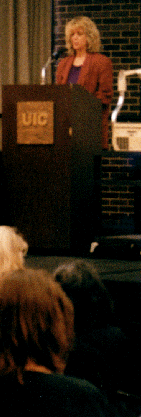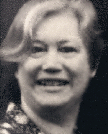Kotex ad emphasizing shame, 1992
See Kotex items: First ad (1921)
- ad 1928 (Sears and Roebuck catalog) - Lee Miller ads (first real person in a menstrual
hygiene ad, 1928) - Marjorie May's Twelfth Birthday
(booklet for girls, 1928, Australian edition; there are many links here
to Kotex items) - Preparing for Womanhood (1920s,
booklet for girls; Australian edition) - 1920s booklet in Spanish showing
disposal method - box
from about 1969 - "Are you in the know?"
ads (Kotex) (1949)(1953)(1964)(booklet, 1956) -
See more ads on the Ads for Teenagers main page
 
|
 

Your (Male!) Reporter's Dispatch from the 12th Conference of The
Society for Menstrual Cycle Research
Imagine, male visitors to this site, sitting at an impressive banquet
with 100 scintillating, learned people, and everyone in the room was female
except for you and the waiters!
That's what I enjoyed recently in Chicago, amid arcane and not-so-arcane
discussions of everything under the sun, all mixed up with a huge amount
of humor.
I could not have started and survived the Museum of Menstruation without
this sense of humor, folks, and I was glad to see it in many others during
this dinner and in the three-day conference at the University of Illinois
at Chicago. But, of course, the presentations were serious.
 Professor
Martha McClintock (photo at right; Harry Finley
shot all three photos shown here), of the University of Chicago,
who first wrote about menstrual synchrony ("the
McClintock effect") as an undergraduate at Wellesley College in her
senior thesis, opened the conference with a presentation called "Modeling
Menstrual Cycle Changes;" and Lucinda Finley
(I would be proud to claim her as a relative, but I can't), professor of
law at the Buffalo campus of the State University of New York, helped end
it on the third day, speaking with four other panelists about the uneasy
relationship between medicine and business. On the same panel was Professor
Carol Weisman, who splendidly represented Johns
Hopkins, my alma mater; she's at The School of Hygiene and Public Health,
probably the best such school in the world. Professor
Martha McClintock (photo at right; Harry Finley
shot all three photos shown here), of the University of Chicago,
who first wrote about menstrual synchrony ("the
McClintock effect") as an undergraduate at Wellesley College in her
senior thesis, opened the conference with a presentation called "Modeling
Menstrual Cycle Changes;" and Lucinda Finley
(I would be proud to claim her as a relative, but I can't), professor of
law at the Buffalo campus of the State University of New York, helped end
it on the third day, speaking with four other panelists about the uneasy
relationship between medicine and business. On the same panel was Professor
Carol Weisman, who splendidly represented Johns
Hopkins, my alma mater; she's at The School of Hygiene and Public Health,
probably the best such school in the world.
In those three days I picked three more members
of the MUM board of directors, all under
25 years old: Stephanie Harzewski, of Rutgers
University, who vastly increased my knowledge of menstrual extraction with
her paper presentation; Fiona Scorgie, of the
University of Natal, South Africa, who impressively dissected South African
magazine advertising for menstrual hygiene, and who I hope has gotten over
her laryngitis; and Advoquita Stude, a junior
environmental engineering major at the California Institute of Technology,
who will train her blinding intelligence on tampon development. Welcome,
board, to the Museum of Menstruation! and together we will make this museum
and The Museum of the Women's Health THE place to visit!
I met MUM board member Dr. Barbara Czerwinski
(and her younger daughter Mary Ann), of the University of Texas,
for the first time, and she lives up to all my highest expectations of wit,
charm, good sense and sheer brain power. She seconded my adding young members
to the MUM board. They will give energy and freshness to both museums, and,
I hope, a bit of naivete. I used that latter quality to stumble along, pushing
MUM into unknown thickets, mosquitoes nipping me, but reaching the village
of the world public! Now for the women's health museum!
  Leading the festivities at the above-mentioned
banquet was Dr. Alice Dan (picture far left),
new president of The Society for Menstrual Cycle Research, who works with
the sponsor of this 20th anniversary conference, the UIC Center for Research
on Women and Gender. In the photo at near left we see the outgoing president,
Janine O'Leary Cobb, president of A Friend
Indeed Publications, Inc., in Montreal, Canada. Leading the festivities at the above-mentioned
banquet was Dr. Alice Dan (picture far left),
new president of The Society for Menstrual Cycle Research, who works with
the sponsor of this 20th anniversary conference, the UIC Center for Research
on Women and Gender. In the photo at near left we see the outgoing president,
Janine O'Leary Cobb, president of A Friend
Indeed Publications, Inc., in Montreal, Canada.
In what was sheer happenstance, Dr. Susan Love,
a surgeon from the University of California, and author of Dr. Susan
Love's Breast Book (1990) and Dr. Susan Love's Hormone Book (1997),
talked to a full house about the storm centered on the supplemental use
of estrogen and other hormones, especially to treat illnesses such as heart
disease and breast cancer, and also as a "treatment " for menopause
symptoms. She's against it. The happenstance is that I was reading the New Yorker (9 June)
article "The Estrogen Question" on
the plane to the conference, which attacks Dr. Love for her stance. In part,
the article says Dr. Love simply transposed two columns of statistics in
making her point, and will not admit it. In the Tambrands Lecture at the
conference, she said she actually used statistics from another study. I
confess I am confused.
But Dr. Love's position got a good reception among many attendees. Part
of the reasoning involves the acceptance of aging, not fighting it. Menopause is not a sickness, but is treated as such by
many physicians and pharmaceutical companies. Estrogen does protect
against heart disease in post-menopausal women (see the article in last
week's Archives of Internal Medicine), but it slightly elevates the
risk of breast cancer. Actually, the risk of a woman's dying from heart
disease is far greater than that of breast cancer, but the statistics are
complicated. But a recent visitor to MUM pointed out that all these studies
were each conducted for less than eight years, not enough time to really
assess what happens.
Several presentations attacked advertising for menstrual hygiene as
being paternalistic, inaccurate and demeaning, but Dr. Iris
Prager, of the Tambrands ("Tampax") Corporation, defended
her company's ads as providing information about what her company offers,
which is based upon their research on what women want. I too complain about
advertising all the time, but I chirped up with a famous ad man's statement
that advertising reflects society, and does not seek to change it. And what
kind of ad would be acceptable? Another participant said that she does not
want to stain her clothes, so why shouldn't an ad mention, or imply, that
its product prevents staining?
But there was no disputing CupcakeMadness
and "My Friend Is Here," Chicago
performance groups which both gave a presentation about their intents (to
value menstruation), and actually read poetry, sang and danced on the final
day before a delighted Society. After asking who was menstruating (not me!),
they rewarded those raising their hands with prizes, not common practice.
They did a crisp and effective job, and I hope to publish some of their
poetry here within a few weeks.
Many presentations dealt with current research in menstruation and menopause;
five were given by men. This writer gave a poster presentation about MUM
and his ideas about the future Museum of Women's Health.
In two years I hope to be giving you a similar report from the next
conference, which will possibly be in San Francisco.
I can't wait!
What Do Women Use in New Guinea?
After visiting the MUM Web site, a reader in Canberra, Australia,
e-mailed this:
We were fascinated with your Web site. I found it through "The
Keeper" site advertised in the Herb Companion Magazine.
Anyhow, I thought you may be interested to know that during the 70's,
during my teens, my parents lived in Papua, New Guinea. My mother got friendly
enough with some New Guinean women to ask them how they dealt with menstruation
in the village. The reply surprised us. They said they used the coir
[fiber, sometimes used to make rope, etc.] from coconut
husks in place of sanitary napkins!
Keep up the good work.
I will resume bringing you medical information in this spot next week.
Did You E-mail Me in the Last Few Weeks?
Last Saturday I lost everything in my Eudora
mail system, including all my e-mail addresses and messages, because of
a corrupt file.
Several people sent me their experiences with products, and now they're
gone. PLEASE re-send your messages! I want
to put these on this News page as soon as I can! And
other folks, please also mail me again!
Aren't computers just great? You can't live with them, and you can't
live without them.
The New York Times Will Have
a Special Section on Women's Health, Sunday,
22 June 1997. [An economics
researcher at Syracuse University later told me that the Times praised the site
you are reading - and it mentioned it first!]
© 1997 Harry Finley. It is illegal to reproduce
or distribute work on this Web site in any manner or medium without written
permission of the author. Please report suspected violations to hfinley@mum.org
See ads for menarche-education booklets:
Marjorie May's Twelfth Birthday
(Kotex, 1933), Tampax tampons (1970, with Susan Dey),
Personal Products (1955, with Carol Lynley), and
German o.b. tampons (lower ad, 1981)
See also the booklets How
shall I tell my daughter? (Modess, various dates), Growing
up and liking it (Modess, various dates), and Marjorie
May's Twelfth Birthday (Kotex, 1928).
And read Lynn Peril's series about these and
similar booklets!
See another ad for As One Girl to Another (1942),
and the booklet itself.
|
|
|





 Professor
Martha McClintock (photo at right; Harry Finley
shot all three photos shown here), of the University of Chicago,
who first wrote about
Professor
Martha McClintock (photo at right; Harry Finley
shot all three photos shown here), of the University of Chicago,
who first wrote about 
 Leading the festivities at the above-mentioned
banquet was Dr. Alice Dan (picture far left),
new president of The Society for Menstrual Cycle Research, who works with
the sponsor of this 20th anniversary conference, the UIC Center for Research
on Women and Gender. In the photo at near left we see the outgoing president,
Janine O'Leary Cobb, president of A Friend
Indeed Publications, Inc., in Montreal, Canada.
Leading the festivities at the above-mentioned
banquet was Dr. Alice Dan (picture far left),
new president of The Society for Menstrual Cycle Research, who works with
the sponsor of this 20th anniversary conference, the UIC Center for Research
on Women and Gender. In the photo at near left we see the outgoing president,
Janine O'Leary Cobb, president of A Friend
Indeed Publications, Inc., in Montreal, Canada.